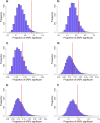Genes of the RNASE5 pathway contain SNP associated with milk production traits in dairy cattle
- PMID: 23865486
- PMCID: PMC3733968
- DOI: 10.1186/1297-9686-45-25
Genes of the RNASE5 pathway contain SNP associated with milk production traits in dairy cattle
Abstract
Background: Identification of the processes and mutations responsible for the large genetic variation in milk production among dairy cattle has proved challenging. One approach is to identify a biological process potentially involved in milk production and to determine the genetic influence of all the genes included in the process or pathway. Angiogenin encoded by angiogenin, ribonuclease, RNase A family 5 (RNASE5) is relatively abundant in milk, and has been shown to regulate protein synthesis and act as a growth factor in epithelial cells in vitro. However, little is known about the role of angiogenin in the mammary gland or if the polymorphisms present in the bovine RNASE5 gene are associated with lactation and milk production traits in dairy cattle. Given the high economic value of increased protein in milk, we have tested the hypothesis that RNASE5 or genes in the RNASE5 pathway are associated with milk production traits. First, we constructed a "RNASE5 pathway" based on upstream and downstream interacting genes reported in the literature. We then tested SNP in close proximity to the genes of this pathway for association with milk production traits in a large dairy cattle dataset.
Results: The constructed RNASE5 pathway consisted of 11 genes. Association analysis between SNP in 1 Mb regions surrounding these genes and milk production traits revealed that more SNP than expected by chance were associated with milk protein percent (P < 0.05 significance). There was no significant association with other traits such as milk fat content or fertility.
Conclusions: These results support a role for the RNASE5 pathway in milk production, specifically milk protein percent, and indicate that polymorphisms in or near these genes explain a proportion of the variation for this trait. This method provides a novel way of understanding the underlying biology of lactation with implications for milk production and can be applied to any pathway or gene set to test whether they are responsible for the variation of complex traits.
Figures


References
-
- Hayes BJ, Pryce J, Chamberlain AJ, Bowman PJ, Goddard ME. Genetic architecture of complex traits and accuracy of genomic prediction: coat colour, milk-fat percentage, and type in Holstein cattle as contrasting model traits. PLoS Genet. 2010;6:e1001139. doi: 10.1371/journal.pgen.1001139. - DOI - PMC - PubMed
Publication types
MeSH terms
Substances
LinkOut - more resources
Full Text Sources
Other Literature Sources
Miscellaneous

